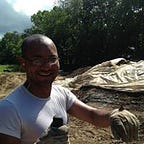On Rural Holons
Our work on designing and building holons (our term for self-sufficient communities capable of building, repairing, and maintaining everything necessary for a modern standard of living, without a global supply chain) is often based in rural areas.
While addressing the main question in our article ‘What would life in a holon look like,’ we talked about why we seem to assume people want a Holon Model for empty land:
Using a simple starting situation, like unoccupied land, lets us figure out everything it would take to build a holon literally ‘from the ground up.’
Figuring out how to build a holon, a for a plot of land that has no utility access, both rural and undeveloped, let us engage with what it would take to realize the holons from Daniel Suarez’s book Freedomᵀᴹ¹, which were based on two real-life rural locations.
The holons discussed in detail in the book are relatively rural, based on two real locations: The Laguna Pueblo in west-central New Mexico, a Native American reservation; and Greeley, Iowa, with its surrounding farms.
The Laguna holon in the book is based around the nearby Enchanted Mesa. In the book, this rock formation is used as the basis for housing and provides useful limestone. In reality, it is in Cibola County, with a population density of 6 people per square mile, and is unoccupied.
Greeley is a small farming community in eastern Iowa with a population of 256. It acts as the manufacturing hub for a holon, with outlying farmers providing agriculture. Greeley is in Delaware County, with a population density of 31 people per square mile.
A ‘city’ has a much more dense population, somewhere between ~10,000 and ~50,000 people per square mile. 500 people per square mile is normal for a town. An area with less than 1,000 people per square mile is considered a ‘rural area.’² Both holons based on real locations in Freedomᵀᴹ are decidedly rural areas.
Our holon designs are located in similarly rural situations, and we drew more from the Enchanted Mesa holon for inspiration because it is more thoroughly described as a holon. The Greeley holon is described better in terms of how its people live.
Our Holon Model is based in rural areas not because it has to be, but because the most comprehensive look at a standalone community is easier with some freedoms. Space to build, a lack of restrictive zoning, sunshine, all of these can be tough to find in urban areas.
Building holons in rural areas with no utilities or development means building everything they need, literally from the ground up. When we figure that out, which you can read about in our article ‘Holon Model Construction Kits,’ we’ll be able to adapt to more developed rural areas such as farms, ranches, hunting lodges, or simple houses in the country.
¹ Suarez, D. (2010). Freedom (TM). New York: Dutton.
² ‘Territory outside of urbanized areas is designated rural and can have population densities as high as 999 per square mile or as low as 1 person per square mile.’ Congressional Research Service glossary of terms.
³ Freedomᵀᴹ, Page 85.
